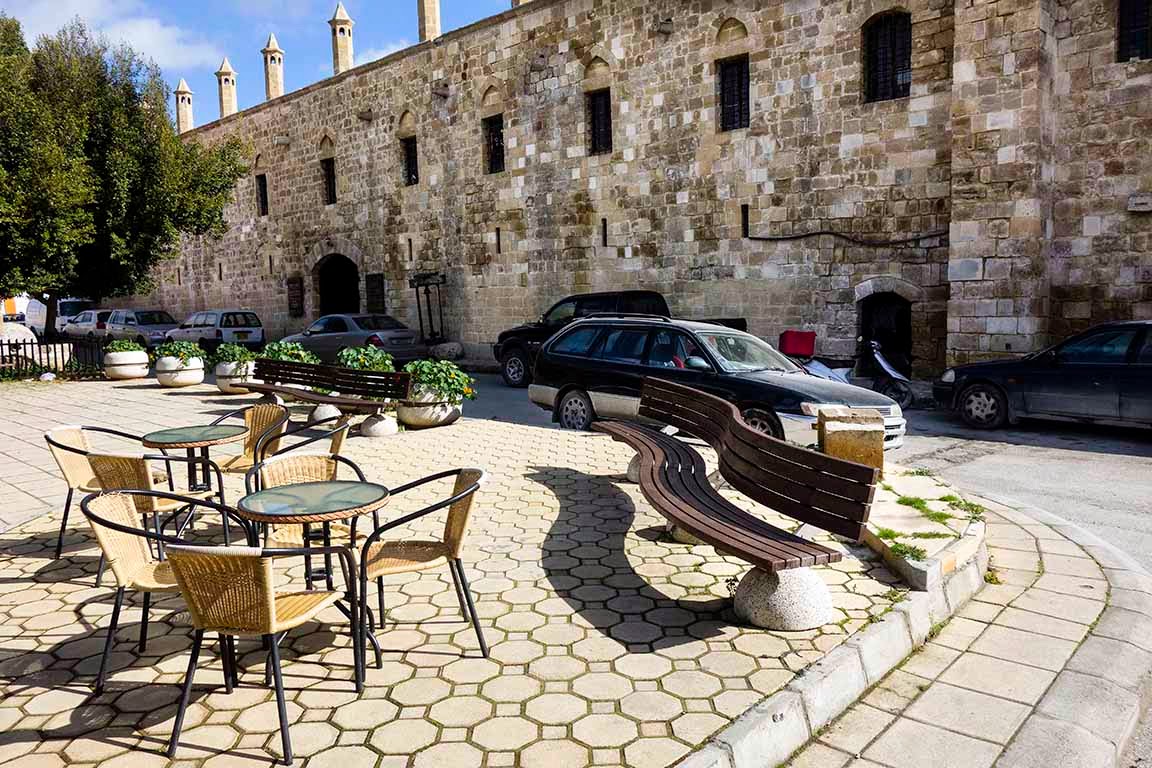Cyprus | Nicosia | Büyük Han
From Larnaca I moseyed up to Nicosia, the largest city on the island of Cyprus. Downtown Nicosia is only twenty-eight miles from downtown Larnaca, but given all the bus stops the trip takes over an hour. Since 1974 Nicosia has been divided into two parts; the northern part in the Turkish Republic of Northern Cyprus and the southern part in the Republic of Cyprus. At the risk of over-oversimplifying a very complicated and contentious issue, let it be said that the Republic of Cyprus is Greek and Christian and the Turkish Republic of Northern Cyprus is Turkish and Muslim. The Turkish Republic of Northern Cyprus was created after the invasion of Cyprus by Turkey in 1974. Since then Nicosia has been a divided city. The border separating the two parts of Nicosia is to this day administered by the United Nations. Although there were numerous sights I wanted to see in both southern and northern Nicosia my first objective was the Büyük Han, or caravanserai, in northern Nicosia. I was curious how it would compare to caravanserais in Istanbul, Bukhara, and Sogdiana.
From 1974 to 2003 the northern and southern parts of Nicosia remained completed separated, with no access between one side and the other. On April 23, 2003 the so-called Ledra Palace border crossing was established, and later, on April 3, 2008 the Ledra Street pedestrian crossing was opened. This crossing is used mainly by day-trippers from one side of the city to the other. Thus I presented myself at the Ledra Street crossing point when it opened at eight in the morning. There was no line and apparently I was the first person to cross that day. At the first checkpoint an official examines your passport and then waves you on to a second checkpoint 150 feet farther up the street. Here you show your passport again and fill out a short form (the so-called White Paper), which is then stamped. This serves as a one-day visa to Northern Cyprus. Your passport is not stamped.
There had been no coffee shops open on Ledra Street and I had been unable to get a caffeine fix before crossing over. On the north side there were numerous coffee and tea houses on the quiet street leading to the center of town but none of them were open. Cypriots, I have noticed, are not early risers. Signs in both Turkish and English point the way to the Büyük Han. I soon arrive at the western entrance. Happily the door is open and inside several cafes are serving up Turkish coffee (in the southern part of Nicosia and the rest of the Republic of Cyprus this same drink is universally known as “Cyprus coffee”).
The han is 443 years old. It was built by Turkish Governor-General Muzaffer Pasha in 1572, two years after the Ottomans seized Cyprus from the Venetians in 1570. It was originally called Alanyalilar’s Han, but by the seventeenth century it had become known as the Büyük (Big) Khan, since it was the largest han in Nicosia. The two story structure has sixty-eight rooms which open onto an interior courtyard. It would have been used as an inn and business center for prosperous traders from Asia Minor, the Levant, northern Africa, and Europe. The rooms, which now house shops selling assorted tourist-oriented tat, were fairly roomy and each had it own hearth. One can only imagine that these were pretty comfortable and even luxurious lodgings back in the sixteenth century. This was probably the equivalent of a modern day five-star business hotel, catering to successful and affluent merchants from all around the Mediterranean Basin and beyond. I would like to think that I would have been able to stay here had I arrived in Nicosia in the sixteenth or seventeenth century, but more likely I would have ended up at one of the nearby Sufi-run tekkes, which by tradition provided free food and lodging, at least for a night or two, to indigent travelers wandering down the endless corridors of time and space.
The west side of the han, with one of the entrances (click on photos for enlargements).
The east side of the han, with the other entrance to the han at the far left. To the right of the eastern entrance is a barrel vaulted gallery.
The barrel vaulted gallery
To the left of the eastern entrance is a groin vaulted gallery. Why different styles of galleries were used on either side of the entrance is a detail lost to history.
A tiny mosque in the middle of the courtyard
The tiny mosque
View of the courtyard and facing rooms
View of the courtyard and facing rooms
View of the courtyard and facing rooms
View of the courtyard and facing rooms
View of the courtyard and facing rooms
View of the courtyard and facing rooms
View of the second floor gallery
Cafe where I had coffee. I am beginning to regret the Intemperate Remarks I have made about coffee in the past.
















